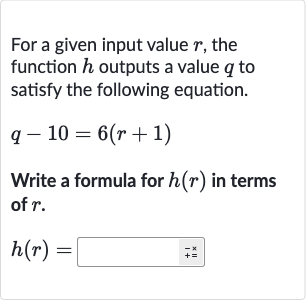Full solution
Q. For a given input value , the function outputs a value to satisfy the following equation.Write a formula for in terms of .
- Isolate in the equation: To find the formula for , we need to express in terms of . We start by isolating on one side of the equation .
- Distribute the through the parentheses: Add to both sides of the equation to isolate .
This simplifies to: - Combine like terms: Now distribute the through the parentheses.
- Write the function : Combine like terms ( and ) to simplify the equation further.
- Write the function h(r): Combine like terms ( and ) to simplify the equation further.q = r + Since h outputs q for a given input r, we can write the function h(r) as:h(r) = r +
More problems from Find the inverse of a linear function
QuestionGet tutor help
QuestionGet tutor help
QuestionGet tutor help
QuestionGet tutor help
QuestionGet tutor help

